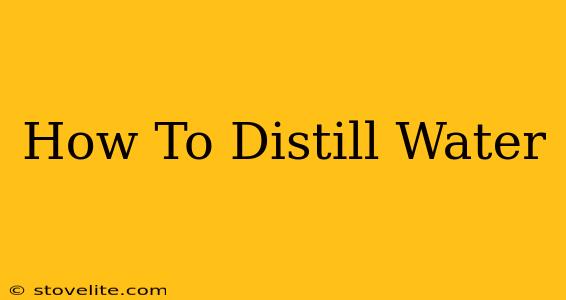Distillation is a process that separates components or substances from a liquid mixture by using selective boiling and condensation. It's a powerful technique for purifying water, removing impurities like minerals, bacteria, and other contaminants. Whether you're a prepper, a survival enthusiast, or simply interested in producing the purest water possible, understanding how to distill water is a valuable skill. This comprehensive guide will walk you through the process, covering everything from the equipment you'll need to troubleshooting common issues.
Understanding the Distillation Process
The core principle behind water distillation is simple: boiling and condensation. Water boils at 100°C (212°F) at sea level. When you heat water, it turns into steam, leaving behind solids and other non-volatile impurities. This steam is then cooled and condensed back into liquid water, resulting in a purer form.
Stages of Water Distillation:
- Boiling: The impure water is heated to its boiling point, causing it to evaporate.
- Vaporization: The water turns into steam, carrying volatile impurities. However, many contaminants remain in the boiling pot.
- Condensation: The steam travels through a cooling system (like a condenser), where it cools and turns back into liquid water.
- Collection: The purified water (distillate) is collected in a clean container.
Equipment Needed for Water Distillation
You can create a simple water distiller at home, or you can invest in a more sophisticated unit. Here's what you'll need:
- Heat Source: A stovetop, camping stove, or even a dedicated distiller with a built-in heating element.
- Boiling Pot: A stainless steel pot is ideal as it's resistant to corrosion and doesn't leach chemicals into the water. Avoid using aluminum or non-food grade containers.
- Condenser: This is crucial. It can be as simple as a coil of copper tubing immersed in a cold water bath, or a more complex system for larger-scale distillation. A good condenser ensures efficient condensation of the steam.
- Collection Container: A clean, sterile glass or food-grade plastic container to collect the distilled water.
- Thermometer (Optional): Helpful for monitoring the water temperature and ensuring it reaches boiling point.
- Cooling Water Source: A constant supply of cold water is crucial for efficient condensation.
Building a Simple DIY Water Distiller
For a basic setup, you can adapt common household items:
- The Pot: Use a large stainless steel pot.
- The Condenser: Use a coil of copper tubing. Secure one end of the tubing to the lid of the pot, ensuring a tight seal to prevent steam escape. Run the other end of the tubing into a container filled with cold water, changing the water frequently to maintain a cold temperature.
- The Collection Container: Place a clean container beneath the end of the copper tubing to collect the distilled water.
Important Note: Always ensure the setup is stable and prevent any potential fire hazards.
Troubleshooting Common Issues
- Slow Distillation: Check your heat source, the efficiency of your condenser (is your cooling water cold enough?), and ensure a good seal between the pot and condenser.
- Cloudy Distillate: This indicates the presence of impurities. Ensure the condenser is clean and consider using a better quality water source.
- Metallic Taste: This might suggest your pot or condenser is reacting with the water. Use stainless steel and avoid using aluminum or other reactive metals.
Benefits of Distilled Water
- Purity: Removes dissolved minerals, bacteria, and many other contaminants.
- Health Benefits: Ideal for those sensitive to minerals in their water. Distilled water is often used in medications and intravenous solutions.
- Appliance Protection: Prevents mineral buildup in appliances like irons and humidifiers.
Things to Consider
- Mineral Depletion: Distilled water lacks essential minerals naturally found in tap water. While this is beneficial for some, it might not be optimal for others.
- Environmental Impact: Distillation requires energy, so it's not the most environmentally friendly method of water purification.
By following these steps, you can successfully distill water and enjoy the benefits of pure H2O. Remember safety first, and always prioritize using clean equipment and a safe heat source. Enjoy your purified water!

